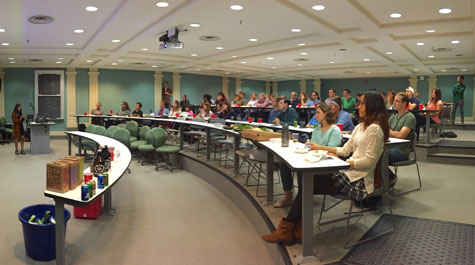W&M grad students start interdisciplinary club for sharing research
On a quiet Thursday evening, Ike Irby, a joint graduate degree student between William & Mary’s Virginia Institute of Marine Science and the university’s public policy program, stood in front of a crowded classroom in McGlothlin-Street Hall lecturing about the hierarchal structure that guides scientific policy in the White House.
Irby wasn’t speaking solely to a room full of scientists or even science enthusiasts. Instead, the crowd was comprised of graduate students in fields ranging from physics to history and anthropology, lured as much by shared knowledge as they were by the promise of free pizza. For the organizers of the event, that’s exactly the point.
“It was basically born out of a desire for graduate students to meet each other, mingle between departments, and to learn about the research being conducted across the Arts & Sciences,” said Andrew Kottick, a Ph.D. student in applied science.
Journal Club, a weekly gathering for sharing research with W&M Arts & Sciences and VIMS graduate students, was founded by Kottick and Sean Koebley, a fellow Ph.D. candidate in applied science, this past spring. Held every Thursday at 5:30 P.M. in McGlothlin-Street Hall, the event includes a 30-minute TED-style talk and Q&A with a graduate student, plus time to mingle over food and drinks before and after. This semester, Journal Club attendance has increased 40 to 50 percent, attracting an average of 60 students each week.
“Last semester we started this as a sort of experiment to see if we could get the logistics down,” said Koebley. “Now our goal is to make this part of the graduate student culture.”
The two students got the idea to start Journal Club from a similar program Kottick experienced at his master’s degree alma mater. In the fall of 2015, they began advertising and petitioning across campus to get funding for their somewhat unconventional offerings.
“It was a new idea, but I think people ultimately saw the value of the club pretty quickly,” said Kottick.
Most of the Journal Club’s funding comes from private donors within the Graduate Studies Advisory Board, with additional money for food coming from various sponsors including the Office of Graduate Studies and Research, the Reves Center for International Studies, and VIMS.
Each week, students give presentations on topics ranging from ultracold atoms to archaeological wood sourcing. The presenters and their abstracts are all pre-approved and scheduled by Kottick and Koebley to ensure departmental diversity throughout the semester. While some students are recruited, Kottick and Koebley said many are happy to volunteer for their own benefit.
“I’m finishing my Ph.D., and in every job and post-doc interview I’m going through, I’m expected to give a 45-minute talk on my research and the work my lab does,” said Kottick. “Other than at the Graduate Research Symposium, there aren’t really many opportunities on campus to present work. That’s an important skill to have, especially if you want to stay in academia.”
Each student who presents receives anonymous feedback forms from their peers, and, in the future, Kottick and Koebley are considering filming the talks and inviting guest professors in to offer insight. Outside of the academic benefit, they’re focused on steadily increasing attendance in future semesters and continuing to encourage interdepartmental friendships and, potentially, collaborations.
“I think the very fact that we have an average of 60 graduate students coming together every week is very valuable for the Arts & Sciences program,” said Koebley. “That’s a routine and a community that we didn’t have before.”
 Skip to main content
Skip to main content

